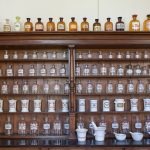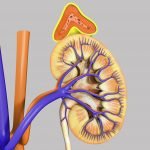Thyroid Hormone as Fertility Treatment
Lorilee Schoenbeck, ND
Americans are having children later than ever. The U.S. Census Bureau estimates that between 1960 and 2005, the primiparous woman’s average age at delivery rose from 20 to 26. This translates into more women seeking fertility treatments in their 30s and 40s, when their bodies aren’t complying with their desire to have full-term pregnancies.
This article addresses the perhaps controversial approach of “turning back the clock” for women older than 30 with the use of low-dose thyroid supplementation in clinically normothyroid individuals experiencing infertility.
Treating Clinical Thyroid Disease
The importance of treating clinical thyroid disease, and even the entity known as “subclinical hypothyroidism” (TSH levels between 5-10μIU/mL) in cases of infertility, subfertility and spontaneous abortion, are well documented. This is also the case for the prevention of a host of other gestational complications, as well as fetal development issues. Additionally, in 2002 the American Association of Clinical Endocrinologists released treatment guidelines recommending a target TSH value of 0.3-3.0μIU/mL for subclinically hypothyroid patients (www.aace.com/pub/guidelines/). However, though naturopathic physicians tend to adopt this tighter reference range for patients, and indeed often utilize thyroid support in various forms for normothyroid infertility patients whose lab values are within range, precious little data exist to support this practice. My hope is to instigate discussion and, ultimately, clinical research into the potential risks and benefits of this highly accessible treatment for infertile women in their 30s and 40s who frequently present with TSH values between 3.0 and 5.0μIU/mL. Three recent cases from my practice illustrate some of the potential benefits and risks of this treatment (see the accompanying Case Studies.)
Case Study 1
April 2005: A 37-year-old P1G1 presents after 15 months of attempting to conceive. Gyn Hx significant for oral contraceptive use for 14 years (temporarily discontinued to conceive and give birth to a daughter 7 years ago.) Husband has normal sperm count and motility. The patient had a normal hysterosalpingogram (HSG) 6 months ago.
Labs: normal estrogen, progesterone, LH and FSH tests; TSH of 3.69μIU/mL. Patient used a urine LH test kit, which showed that she ovulates monthly, although spinnbarkeit mucus is evident 2 days later. Cycles q 25-30 days. The patient recorded a consistent 0.4-degree Fahrenheit elevation in BBT mid-cycle, which gradually falls after day 18.
Past treatments for infertility included natural progesterone cream days 14-28 (1/4t Progonol = 32.5mg/day), T3 supplementation 7.5μg bid (both via another ND provider), which the patient says caused uncontrollable crying/emotions and one heavy period during week 3 of her cycle. She also took clomiphene citrate treatments for 3 months, which “helped temperatures stay up,” but did not result in pregnancy.
Therapeutic goal: Support luteal phase to allow for maintenance in elevated temperature. Continue utilizing low-dose thyroid supplementation, but find a form that the patient tolerates better.
Treatment: Switch from T3 to glandular thyroid USP 30mg q am; replace progesterone cream with Vitex tincture, 60gtt bid.
4-Week Follow-Up: TSH is 3.32μIU/mL; glandular thyroid raised to 45mg/d. Patient is tolerating glandular better than T3, as per greater mood stability.
6-Week Follow-Up: Patient maintaining luteal temperature increase of 0.4 degrees F throughout remainder of cycle.
12-Week Follow-Up: TSH rechecked on 45mg glandular thyroid; value: 3.59μIU/mL. Dosage increased to 60mg/day. Vitex consistent at 60gtt bid.
16-Week Follow-Up: The patient reported menses lasting 7 days (normally, it lasts 3 days.) Cycles are closer to 28 days.
18-Week Follow-Up: TSH rechecked on 60mg thyroid; value: 0.89μIU/mL.
20-Week Follow-Up: Patient noted that the higher dose of glandular thyroid causes more mood swings, but she can tolerate them. She is now maintaining a 0.7-degree F temperature elevation during luteal phase. Her spinnbarkeit mucus now coincides with day 14 of her cycle and the day of temperature elevation. This is ideal.
36-Week Follow-Up: Patient discontinued Vitex “just to see what my body would do.”
42-Week Follow-Up: Patient pregnant.
76-Week Follow-Up: Patient delivers a healthy baby boy, following a healthy pregnancy. Thyroid gradually tapered off over 3 months.
Case Study 2
October 2003: 41-year-old P2G0, two therapeutic abortions, has been attempting pregnancy since December 2002. She thinks she may have had an early miscarriage two months ago (large “gush” while menstruating).
Prior workup: Partner’s sperm count normal, motility sub-optimal. HSG normal. Cycles q 28 days. The patient maintains a 0.5-1.0-degree F elevation in BBT during follicular phase.
Labs from 1 month prior: Day 3 FSH is 12.1mIU/mL, indicating transition toward menopause. TSH 3.34μIU/mL. Mother is hypothyroid; the patient has been gaining weight (30+ pounds) since age 37.
Therapeutic goal: Lower Day 3 FSH to preferred “fertile” levels (<8mIU/mL) and optimize thyroid (TSH between 0.35 and 3.0μIU/mL).
Treatment: Glandular thyroid 30mg/day; Vitex 60gtt bid to lower FSH.
4-Week Follow-Up: TSH rechecked. Value: 3.45μIU/mL.
9-Week Follow-Up: Patient decided to use clomiphene citrate and intrauterine insemination (IUI) via university infertility clinic. She was instructed to discontinue Vitex, but stay on 30mg thyroid qd.
19-Week Follow-Up: Clomiphene citrate/IUI treatments lasted two months: patient “felt pregnant” (i.e., extreme nipple tenderness), which abated, and no pregnancy resulted. Meanwhile, FSH has decreased to 6.7mIU/mL (probably from thyroid supplementation, as Vitex treatment was sporadic). Patient decided to take a break from clomiphene citrate/IUI treatment. She was instructed to begin Vitex again, and maintain glandular thyroid. Based on the assessment that she may be getting pregnant but not sustaining the pregnancy, she was also instructed to use natural progesterone pellets if she “feels pregnant” beginning at 25mg bid, increasing by 25mg/day up to a maximum dose of 300mg/day sublingual (SL) pellets.
29-Week Follow-Up: The patient had one more round of unsuccessful clomiphene citrate/IUI treatments in March 2004, and was “finished” with the university infertility clinic. She had not been taking Vitex in 2004, but began just 3 weeks prior to this follow-up. Patient now on 30mg thyroid and 60gtt Vitex bid. She also added 500mg evening primrose oil.
46-Week Follow-Up: Patient pregnant. She presents for help “keeping this baby.” She is also working with a local certified nurse-midwife for prenatal and natal care. Labs: hCG 122mIU/mL, progesterone low at 19.3ng/ml (reference range 11.9-90), low RBCs at 3.76M/cmn, serum protein low at 6.3g/dl (reference range 6.5-8.0). Tx: Increase dietary protein, iron-containing foods, 50mg/day progesterone pellets.
52-Week Follow-Up: The patient reported spotting 6 weeks earlier and passing a lot of tissue 4 weeks earlier. hCG, Fe labs were ordered. In advance of labs, we assumed the pregnancy was still viable, and increased progesterone to 200mg/day SL. Tea of Dioscorea villosa (wild yam), Viburnum prunifolium (black haw) and Chamaelirium luteum (false unicorn root) also prescribed; sip 3c/day. If bleeding or spotting persisted, the patient was instructed to maintain bed rest and utilize 250mg progesterone suppository qd.
54-Week Follow-Up: hCG positive, titer 46,592mIU/mL at 6-7 weeks (reference range at week 6 is 2,200-74,200.) Pregnancy maintained.
60-Week Follow-Up: Fetus tests positive for Down’s Syndrome (trisomy 21). Parents decide to terminate pregnancy.
62-Week Follow-Up: Vaginal delivery induced in hospital, fetus dies in labor.
78-Week Follow-Up: Vaginal bleeding has been occurring ever since labor and delivery; patient is anemic. Tx: Vitex and Achillea millefolium (yarrow) tinctures 60gtt bid (both) and Rubus strigosus (red raspberry leaf) tea. Bleeding stops within 2 days.
88-Week Follow-Up: Patient and her partner receive healthy adopted girl and are very happy.
Case Study 3
October 2004: 34-year-old P1G0, one therapeutic abortion, with newly diagnosed hypothyroidism, attempting pregnancy x 1.5 years. No fertility workup yet. “Viral” thyroiditis April 2004 now progressing to hypothyroidism. Patient is on synthetic levothyroxine 25mcg/day, but TSH is not stable; indeed, she alternately feels hypo- and hyper- thyroid symptoms. Day 3 FSH is optimal at 5.4mIU/mL. Cycles are 28 days. Patient ovulates according to urine LH kit between Days 10 and 14. Co-management with patient’s nurse practitioner; we decide to “wait until her thyroiditis/hypothyroidism is more stable” before proceeding with increased supplementation. Patient was instructed to take BBTs and a tincture of Leonurus cardiaca (motherwort), Vitex, Fucus vesiculosis (bladderwrack) and Chamaelirium 60gtt tid.
18-Week Follow-Up: Recent TSH 5.25μIU/mL; patient anxious to get pregnant. Suggested patient ask her NP to increase synthetic T4 to 0.0375mg, which was done. BBT elevation by 0.5 degrees F on Days 12-13 of cycle and maintained throughout follicular phase.
28-Week Follow-Up: Patient reports her NP increased T4 to 0.05mg on April 1. She feels good on this dose; neither hypo- nor hyper- thyroid symptoms. Husband recently tested low in both sperm count and motility, and was referred to an ND/LAc colleague for treatment. TSH is 2.02μIU/mL on her current dose of T4.
39-Week Follow-Up: TSH value 2.65μIU/mL. BBT elevation does not hold. T4 increased to 0.065mg and Vitex tincture increased to 90gtt tid.
45-Week Follow-Up: BBT increase of 0.5 degrees F still didn’t hold last month. Angelica sinensis (dong quai) 30gtt bid added to above plan Days 8-16 to support ovulation. Final plan includes: T4 0.065mg qd, Vitex 90 drops tid, Angelica sinensis 30gtt bid Days 8-16.
54-Week Follow-Up: Patient becomes pregnant.
90-Week Follow-Up: Patient delivers a healthy girl nine months later, following a healthy pregnancy.
Discussion of Case Studies
Case Study 1 illustrates a healthy outcome of utilizing thyroid in infertility in a 37-year-old normothyroid woman. Whether a goal of TSH levels below 3.0, 2.5 or 2.0μIU/mL is optimal for fertility is a topic for debate. (TSH levels should always be maintained above 0.3μIU/mL.) Additionally, information is not available concerning whether thyroid supplementation should be gradually discontinued after the first trimester, or maintained throughout the pregnancy or beyond. It is of paramount importance that the patient’s thyroid be monitored via symptoms, exam and serum testing, perhaps as often as every 6 weeks, to eliminate the risk of over-supplementation. It is also imperative that the patient’s prenatal team be advised of her thyroid therapy, and participate in the oversight. Clear and honest communication with the patient about potential signs, as well as the unknowns about this approach, is mandatory before beginning treatment.
Case Study 2 illustrates that it is possible to interfere with the vis medicatrix naturae through the use of glandular thyroid, progesterone and possibly Vitex agnus-castus. In other words, these may be tools that can biologically turn the clock backward for reproductive function, even if a woman’s follicles contain defects that the body would possibly detect, and therefore eliminate the pregnancy on its own. It is important to strongly counsel older patients that the risk of aneuploidy or other birth defects increases with age, and that any attempt to become pregnant, especially after age 40, incurs those risks. It is even important, in my opinion, to have and document a discussion with the patient about the wisdom of “going against nature” in the quest for fertility.
Case Study 3 shows us the importance of achieving normalized thyroid levels in hypothyroid patients before pregnancy can be achieved. Before the thyroid gland eventually settles into a predictable level of function, in active cases of thyroiditis the clinician (and patient) may feel a little like she is riding a bucking bronco while continuously adjusting doses based on symptoms and monthly lab values. Patients with a ticking “biological clock” may have little patience to wait out the thyroiditis, which adds another challenge. Education, encouragement of patience and careful monitoring before and after pregnancy is achieved are important.
 Lorilee Schoenbeck, ND practices at Vermont Women’s Choice Gynecological Associates, which is owned by Planned Parenthood of Northern New England. She is the author of Menopause: Bridging the Gap Between Natural and Conventional Medicine (Kensington, 2002). Dr. Schoenbeck teaches widely at institutions such as Omega Institute, Kripalu Center, University of Vermont College of Medicine and Johnson State College in Johnson, Vt. She lives in Burlington, Vt., and enjoys hiking with her dog, home renovation projects and practicing yoga.
Lorilee Schoenbeck, ND practices at Vermont Women’s Choice Gynecological Associates, which is owned by Planned Parenthood of Northern New England. She is the author of Menopause: Bridging the Gap Between Natural and Conventional Medicine (Kensington, 2002). Dr. Schoenbeck teaches widely at institutions such as Omega Institute, Kripalu Center, University of Vermont College of Medicine and Johnson State College in Johnson, Vt. She lives in Burlington, Vt., and enjoys hiking with her dog, home renovation projects and practicing yoga.
SIDEBAR 1










